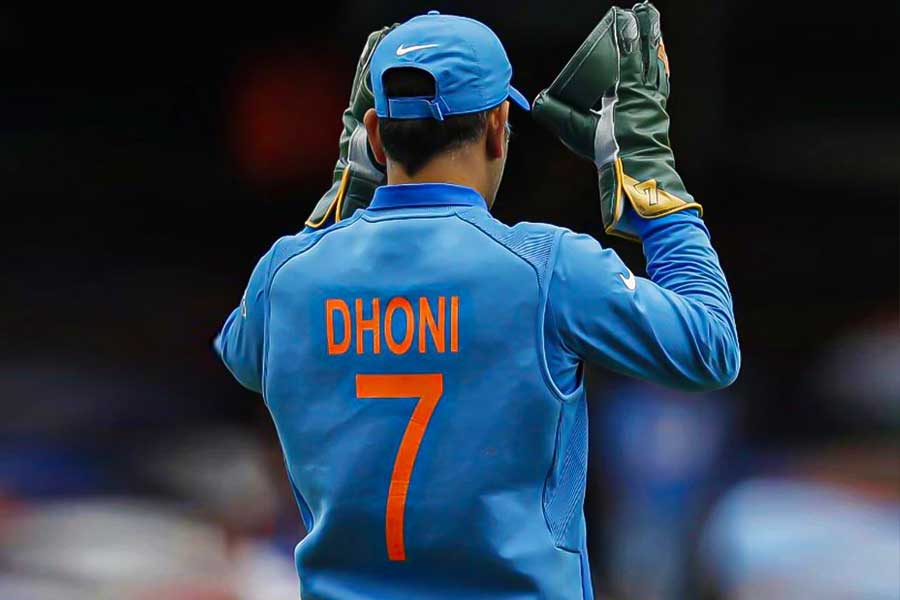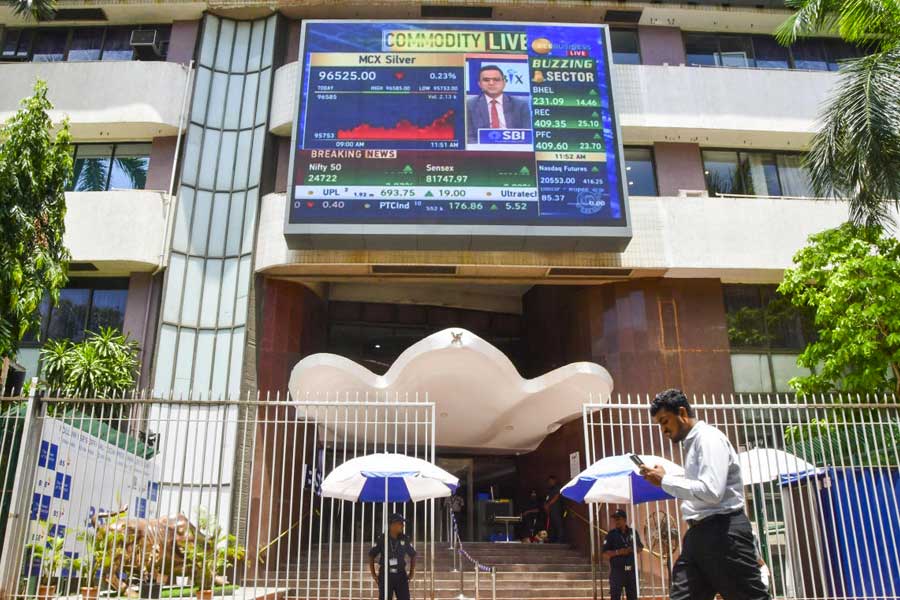 |
P. Mitter, aka Feluda, private detective, spills the most secret possession of a man, his vital stats — 26-26-26.
“What, are you a pig?” blurts out Lalmohanbabu, aka Jatayu, writer of detective novels.
Physically, that’s one kind of Bengali-speaking Calcuttan, henceforth to be referred to as Bengalis.
That was in Sonar Kella, Satyajit Ray’s first Feluda film. In Joi Baba Felunath, the trio of Feluda, Jatayu and Topse meet in a Kashi hotel a body-builder who reveals his vital stats — and this time there’s nothing to hide.
Moloy Roy, the real-life body-builder and son of the late Manotosh Roy who became Mr Universe, says in the film: “Eta mandir, ar muscle gulo tar modhye sob karukarjyo (This body is a temple, and these muscles are works of art).”
That’s the other kind of threatened-species Bengali.
In between there are the vast masses of Bengalis who are vital stats-less. Short of stature, dark of complexion, thin of arm and leg, narrow of chest and pillowy of waist, squinty of bespectacled eyes and large of ear.
Then there is the non-Bengali-speaking Calcuttan, henceforth to be called non-Bengalis, whose distinguishing feature — seen with Bengali eyes — is the waistline measured in ghee spoons.
So who’s more body-minded — the Bengali or the non-Bengali?
Money muscle
 |
Fitness centres, the better-known ones, reveal a trend. The non-Bengali outnumbers the Bengali 9:1 in the worst case and 8:2 in the better case.
“Bengalis constitute only 10 per cent of my clients at any gym,” says fitness expert and t2 columnist Preetom Mukherjee Roy, who trains at Gold’s Gym and other fitness centres.
Mukherjee Roy believes the Bengali count is low because at these gyms six pack doesn’t come cheap. “I wouldn’t say that the non-Bengalis are more aware of health or fitness conscious. It’s simply that a greater number of them have the means to spend on getting a better body.”
At Solace (Sunny Park), for example, the annual charges begin at Rs 20,000.
Ranadeep Moitra, who is associated with many high-end gyms, agrees. “I take about 40 consultations in a month, and of these about 30 are non-Bengalis. Eighty per cent of this is because the Bengalis neither have the means nor the inclination to spend on remaining healthy.”
If money is the obstacle to muscle, Bengalis must be picking the less expensive gyms, the pocket-friendly neighbourhood nooks.
The young Bengali often does seek out these places because the charges are moderate, though so are the equipment.
“Bengalis are reluctant to pay for a high-end gym. So they go to the local gym which is cheaper,” says Mukherjee Roy.
Reva Puri, the fitness veteran who charges Rs 800 for 12 classes a month, differs. “Only a quarter of my class consists of Bengalis. But the reason is not that they are reluctant to spend. Not even so much that they are not aware of the need to be fit. But simply that they are too laid-back and do not want to do anything strenuous,” says Puri.
It’s true that ability to pay is often not the decider. “People in IT have money, but not the time to go to the gym or a fitness centre. The better you do professionally, the less time you have for yourself,” says Krishnendu Paul, who runs Conversys Technologies.
Who needs muscles?
 |
Why go to a gym at all is the hardest question to answer for a Bengali. Socially and culturally, six pack is not only discouraged, but someone spending time to build brawn could even be laughed at. It’s a dumb thing.
Play chess, instead, Khoka, give your brain some muscle! So Khoka moves pawns rather than pumping iron.
It wasn’t always so, says the actor Tota Roy Chowdhury. “Traditionally, Bengalis have been great body-builders. Every locality had an akhara and the boys would work out regularly. It was in the 70s or 80s that this culture started degenerating.”
Tota, who takes care of his body, sees signs of the trend reversing. During the freedom movement, building a strong body was part of the training. Young boys were forced to develop brawn and brain simultaneously. Rabindranath Tagore wrote (Jibansmriti) about morning wrestling lessons in childhood, which didn’t seem to have retarded his intellectual ability.
Avishek Ghosh, a businessman and ex-sportsman, says: “I think Bengalis are gifted in many ways, but they are not motivated to make themselves look good… I can’t go to the gym. The very thought of watching myself on a treadmill in the mirror opposite me is boring.”
There may be something in what he says.
Ghosh, however, thinks the Bengali is changing. Maybe, they are watching too much Salman Khan — stars are often the influencer.
Gagan Sachdev, the managing director of Bodyline, a chain of club-level gyms with fees of about Rs 1,000 a month, bears him out. “Fifty per cent of our clients are Bengalis and in the 14-24 age group. But the number of Bengalis drop significantly in the above-30 age group.”
That is the age when they become old enough to walk. Arijit Nag has come of walking age early. “I have lost 5 kg just by restricting my diet and walking. I often walk to work and back. That saves money and gives me physical exercise,” the 26-year-old says with a grin.
The great thing about walking is you walk when you feel like it. It’s an individual freedom thing.
Gym regulars, however, turn up their noses at “walk”. Pulkit Chawla, training for a year and a half, says: “Calcutta streets are always so crowded. The weather may be too sunny or wet. At the gym, the trainers ensure that you work out.”
Besides, any old walk isn’t enough. There are walks and walks (see box).
Muscles for seasons
There are times when the Bengali would train — without being whipped by the trainer.
“Many Bengalis join the gym just before the pujas because they want to look good. After the festival, 80 per cent of them drop out,” says Sachdev.
Wedding, one’s own or of someone in the family, is another such occasion, says Soumen, of the popular chain Soumen’s Workout.
Smita, who works in the media, went to a gym before her marriage. “The goal was to look good on my wedding day. After that I didn’t continue.”
Soumen talks about another get-in-shape season. “Bengalis will work out strenuously for three months. Once they have the desired figure and I tell them that now they may relax the vigilance on what they eat and prescribe a 20-minute workout at home, they go on a binge without working out.”
Non-Bengalis, on the contrary, “once they have lost (weight), even if I tell them that they can work out at home, will continue to come thrice a week,” adds Soumen.
Even doctors have noted the lopsided non-Bengali to Bengali workout ratio. Cardiac surgeon Kunal Sarkar, a fifth of whose patients go to the gym, says: “Of this 20 per cent, over 60 per cent are non-Bengalis.”
Muscles are in mouth
In a recent national survey, Bengal was described as a land of Indo-European people with isolated tribal populations, which in short means all the world’s bloodlines lead to the Bengali. It has also meant that the Bengali is not a natural athlete — for proof look at the medals cupboard.
They are likely to feel more comfortable at the Math Olympiad. But wait, muscles can help in math too. Increased stamina is what Suparna Paul counts as the best benefit of sending her daughter to Soumen’s Workout.
“My daughter would always fall asleep after returning from school. But since she started working out she never needs to sleep during the day,” explains Paul, who works out herself.
Moitra is kind to Bengalis. “Non-Bengalis, because of their eating habits, tend to put on more weight than Bengalis,” the fitness instructor says. His peers don’t share that kindness. Overeating unites Calcuttans, whatever their mother tongue. “Even those who come to work out at the gym eat more than they burn. How will they ever lose weight?” Mukherjee Roy despairs.
Don’t we all — despair, that is, whether we work out or not. And eat, well — well!
Dolon Dutta Chowdhury, 28, a content developer, speaks for the despairing millions. “I love to eat (how strange?). I diet for about 15-20 days, and then tell myself I deserve a treat. I binge on a big piece of chocolate cake or some such delicacy.”
Sad. The story of our lives.
Except that of one Bengali lady, who married food to fitness. The lady, in her forties, would send her trainer to fetch jhaal muri for her while she worked out. She would also ask him to get her sweets from his locality where they made them well.
“I used to laugh and say how will she lose any this way, but she replied, ‘Bangali hoye khabo na?’” Mukherjee Roy recalls.
Celeb take
I have always been into sports. But once I joined films I did not have time. That's when I started working out. Over the years I have built a small gym at home. I work out six days a week for an hour. I also encourage my co-stars, but there are only a few who are serious about it. — Tota Roy Chowdhury, actor
I’m not much of a gym person, but I do half-an-hour of yoga. I also try to eat healthy. I would like to lose a bit more, and tone my upper arms. Size zero doesn't go down well with Bengalis. Ultimately it depends on the individual, and whether she is comfortable with her weight. — Sreelekha Mitra, actor
I am lazy. I work out on the treadmill off and on. I gain and lose weight easily. Bengalis in general are a little laid-back. It has something to do with the weather maybe, the humidity. When I am abroad, I am much more active and go for a jog everyday. — Bickram Ghosh, tabla player
I do 25 push-ups and 70 crunches every day. Still, I have a little paunch. I try to tuck it in, when I am on camera (laughs). Bengalis are not only a little lazy when it comes to exercising, they also prefer a slight plumpness. When I lose weight, people ask me if I have been ill. — Soumitra Ray, singer
Preetom Mukherjee Roy suggests
Brisk walk: As fast as you can walk without breaking into a jog. It involves upper body movement too, so it tones arms as well. Twenty minutes of this is more than enough. But most people don't manage to walk this fast, so brisk walking becomes as fast as you can walk. Thirty to 40 minutes of this is a good exercise.
Cardio or cardiovascular: Any exercise which increases our heart rate to almost double the pulse rate during normal time. It helps blood circulation, regulates diabetes, pressure, heart function, etc. It also improves lung capacity. And it burns calories. This should be done for 20 minutes.
Weights: Weight training or strength training helps firm and tone the body, improves muscular strength and endurance, improves bone density, prevents osteoporosis. It also strengthens the body and helps prevent injury.
Power yoga: This is doing the basic asanas with more intensity and speed. It improves body flexibility and breathing.










